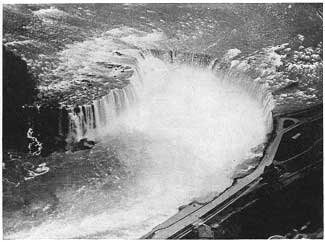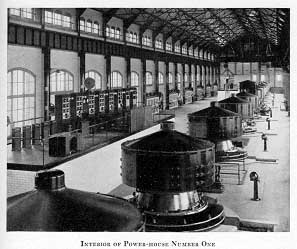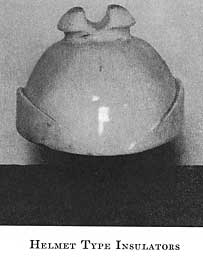1895 - Niagara Falls: The Electrical Wonder of the World
 From
the earliest times, the possibility of harnessing even a tiny fraction of the
falls’ energy brought forth the visionaries, the dreamers and, of course, the
schemers. Early schemes involved locating a large cluster of factories adjacent
to the falls and providing each with a flow of water with which to power its
individual water wheel. The first serious attempt at a hydroelectric generating
plant began in 1890 with the formation of the Cataract Construction Company. By
1893, plans were sufficiently well developed that proposals were solicited from
American and European electrical companies. The scale of the undertaking was
enormous.
From
the earliest times, the possibility of harnessing even a tiny fraction of the
falls’ energy brought forth the visionaries, the dreamers and, of course, the
schemers. Early schemes involved locating a large cluster of factories adjacent
to the falls and providing each with a flow of water with which to power its
individual water wheel. The first serious attempt at a hydroelectric generating
plant began in 1890 with the formation of the Cataract Construction Company. By
1893, plans were sufficiently well developed that proposals were solicited from
American and European electrical companies. The scale of the undertaking was
enormous.
 When
completed, the power plant would house ten generators, each rated at 5,000
horsepower. Up to that time, the largest generator ever demonstrated was 1,000
horsepower. The initial bid was for three generators, together with their
ancillary equipment. The choice came down to General Electric vs.
Westinghouse, with Westinghouse winning the contract. Two generators were
installed and delivered power to a local factory in 1895.
When
completed, the power plant would house ten generators, each rated at 5,000
horsepower. Up to that time, the largest generator ever demonstrated was 1,000
horsepower. The initial bid was for three generators, together with their
ancillary equipment. The choice came down to General Electric vs.
Westinghouse, with Westinghouse winning the contract. Two generators were
installed and delivered power to a local factory in 1895.
 Power
was to be transmitted to Buffalo over a 22-mile, 10kV transmission line. The
weak point of the line was, of course, the insulators. Trial orders were placed
with six manufacturers and the insulators were tested by Cataract engineers.
They all failed, except for the U-937 “Niagara Helmet” designed by Fred Locke
and manufactured by Imperial Porcelain. Its oval shape made this insulator
difficult to produce, so Imperial Porcelain supplied a round version, the U-934,
directly to the contractor building the line. The story is told in detail in
Elton Gish’s great biography of Fred Locke. After the initial start-up period
in late 1896 and early 1897, only these two insulator styles were found
acceptable for service on the line.
Power
was to be transmitted to Buffalo over a 22-mile, 10kV transmission line. The
weak point of the line was, of course, the insulators. Trial orders were placed
with six manufacturers and the insulators were tested by Cataract engineers.
They all failed, except for the U-937 “Niagara Helmet” designed by Fred Locke
and manufactured by Imperial Porcelain. Its oval shape made this insulator
difficult to produce, so Imperial Porcelain supplied a round version, the U-934,
directly to the contractor building the line. The story is told in detail in
Elton Gish’s great biography of Fred Locke. After the initial start-up period
in late 1896 and early 1897, only these two insulator styles were found
acceptable for service on the line.